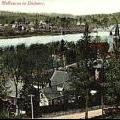 From 1860 to the early 1900s, the St. Francis Valley was the main centre in Canada for the production of slate. At that time, there were no less than ten slate quarries in the area around Richmond, Melbourne, Kingsey, and Danville. Entire villages grew up around the quarries which provided a living to hundreds of workers for the most part from Great Britain.
From 1860 to the early 1900s, the St. Francis Valley was the main centre in Canada for the production of slate. At that time, there were no less than ten slate quarries in the area around Richmond, Melbourne, Kingsey, and Danville. Entire villages grew up around the quarries which provided a living to hundreds of workers for the most part from Great Britain.
Though occasionally red or green, slate is usually gray in colour. Exploited for its natural properties, it is easily split into thin and regular pieces. Relatively soft, it can be sliced, sawed, and drilled. Traditionally, slate was used to make roofs. Its impermeability and resistance to the elements made it ideal.
During the second half of the 19th century, St. Francis Valley slate covered virtually thousands of buildings across Canada. A sign of prestige and good taste, slate was once extensively used in cities like Montreal and Toronto, on well-to-do homes, public buildings, and churches. However, it was also widely used in the St. Francis Valley, on everything from churches to the most humble outbuildings.
Slate fell out of fashion in the early 1900s. It was replaced by factory-made building materials (asphalt shingles, for example) that were cheaper in the short term. The last slate quarries in the Eastern Townships ceased operations in the 1920s, and were abandoned thereafter for most of the century. Since the early 1990s, however, there has been a renewal of interest in slate. In Quebec, since 1995, it has been extracted once more in Saint-Marc-du-Lac-Long, in Témiscouata. In Montreal, and even in Ontario and the Maritimes, roofs on numerous century-old churches and buildings are being restored in traditional slate.